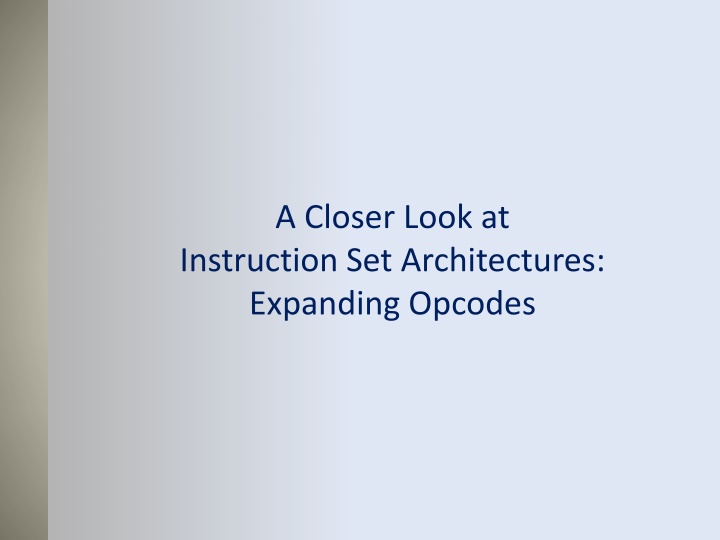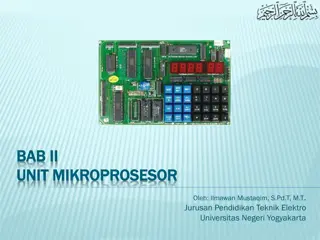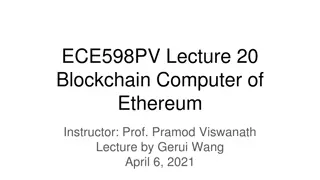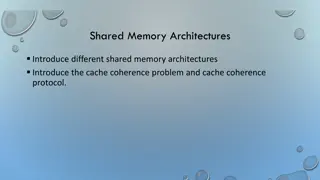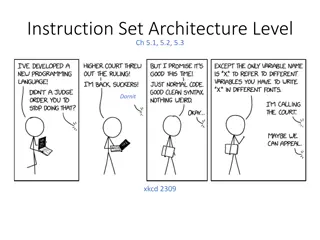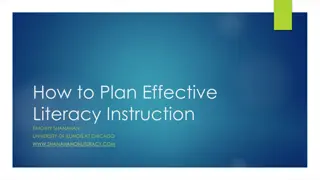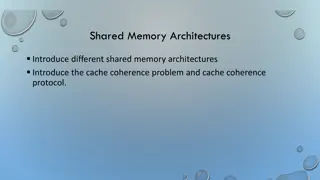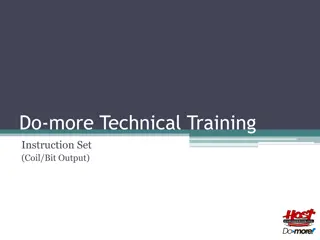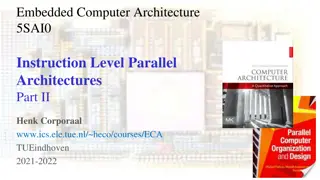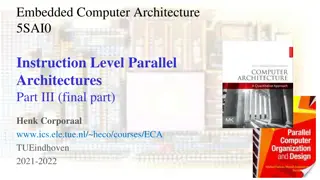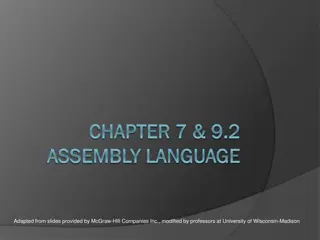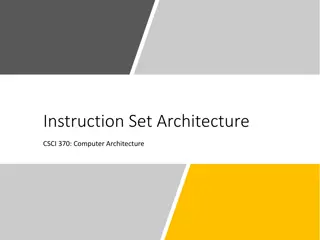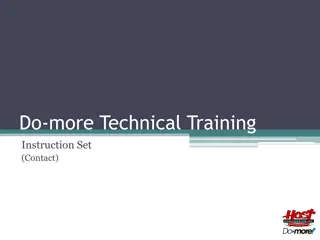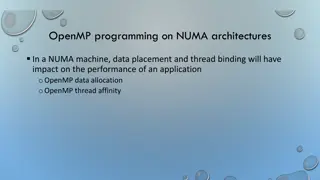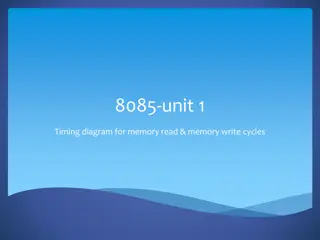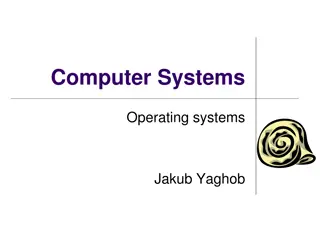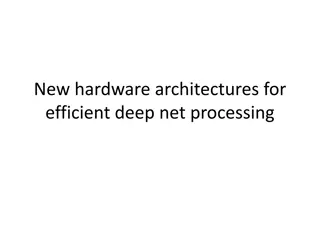Expanding Opcodes in Instruction Set Architectures
Exploring the concept of expanding opcodes in instruction set architectures, this lecture delves into how varying the number of operands affects instruction length and efficiency. By utilizing expanding opcodes, it is possible to accommodate different operand requirements and optimize instruction encoding for improved performance and versatility. Through examples and insights into opcode expansion, the lecture illustrates the benefits and considerations associated with this approach.
Download Presentation

Please find below an Image/Link to download the presentation.
The content on the website is provided AS IS for your information and personal use only. It may not be sold, licensed, or shared on other websites without obtaining consent from the author.If you encounter any issues during the download, it is possible that the publisher has removed the file from their server.
You are allowed to download the files provided on this website for personal or commercial use, subject to the condition that they are used lawfully. All files are the property of their respective owners.
The content on the website is provided AS IS for your information and personal use only. It may not be sold, licensed, or shared on other websites without obtaining consent from the author.
E N D
Presentation Transcript
A Closer Look at Instruction Set Architectures: Expanding Opcodes
Lecture Overview Instruction formats Expanding Opcodes Instruction types Addressing 2
Instruction formats Expanding Opcodes We have seen how instruction length is affected by the number of operands supported by the ISA. In any instruction set, not all instructions require the same number of operands. Operations that require no operands, such as HALT, necessarily waste some space when fixed- length instructions are used. One way to recover some of this space is to use expanding opcodes. 3
Instruction formats Expanding Opcodes The idea of expanding opcodes is to make some opcodes short, but have a means to provide longer ones when needed. When the opcode is short, a lot of bits are left to hold operands So, we could have two or three operands per instruction If an instruction has no operands (such as Halt), all the bits can be used for the opcode Many unique instructions are hence available In between, there are longer opcodes with fewer operands as well as shorter opcodes with more operands. 4
Instruction formats Expanding Opcodes Example 1: Consider a machine with 16-bit instructions and 16 registers. The instruction format can have several structures: - Opcode + Memory address (such as MARIE): If we have 4KB byte addressable memory we need 12 bits to specify an address location The remaining 4 bits are used for the opcode: 16 instruction are hence available - Opcode + Registers Addresses we need 4 bits to select one of the 16 available registers Suppose we have 4 bits opcode, we could encode 16 different instructions with three operands each (3 x 4 bits = 12 bits). 5
Instruction formats Expanding Opcodes Example 2: Consider a machine with 16-bit instructions and 16 registers. And we wish to encode the following instructions: - 15 instructions with 3 addresses - 14 instructions with 2 addresses - 31 instructions with 1 address - 16 instructions with 0 addresses Can we encode this instruction set in 16 bits? Answer: Yes if we use expanding opcodes 6
Instruction formats Expanding Opcodes One possible encoding is as follows: Is there something missing from this instruction set? 7
Instruction formats Expanding Opcodes How do we know if the instruction set we want is possible when using expanding opcodes? We must determine if we have enough bits to create the desired number of bits patterns 8
Instruction formats Expanding Opcodes Going back to Example 2 (Slide 6): The first 15 instructions account for: 15x24x24x24 = 15 x 212 = 61440 bit patterns The next 14 instructions account for: 14 x 24 x 24 = 15 x 28 = 3584 bit patterns The next 31 instructions account for: 31 x 24 = 496 bit patterns The last 16 instructions account for 16 bit patterns In total we need 61440 + 3584 + 496 + 16 = 65536 different bit patterns Having a total of 16 bits we can create 216 = 65536 bit patterns We have an exact match with no wasted patterns. So our instruction set is possible. 9
Instruction formats Expanding Opcodes Example 3: Is it possible to design an expanding opcode to allow the following to be encoded with a 12-bit instruction? Assume a register operand requires 3 bits. 4 instructions with 3 registers 255 instructions with 1 register 16 instructions with 0 register 10
Instruction formats Expanding Opcodes Solution: The first 4 instructions account for: - 4x23x23x23 = 4 x 29 = 2048 bit patterns The next 255 instructions account for: - 255 x 23= 2040 bit patterns The last 16 instructions account for 16 bit patterns In total we need 2048 + 2040 + 16 = 4104 bit patterns With 12 bit instruction we can only have 212 = 4096 bit patterns Required bit patterns (4104) is more than what we have (4096), so this instruction set is not possible with only 12 bits. 11
Lecture Overview Instruction formats Expanding Opcodes Instruction types Addressing 12
Instruction types Instruction types Instructions fall into several broad categories: Data movement instructions - The most frequently used instructions - Data is moved from memory into registers, from registers to registers, and from registers to memory - Examples: Load, Store, Move, Push, Pop, etc. Arithmetic instructions - Include those instructions that use integers and floating point numbers. - As with the data movement instructions, there are sometimes different instructions for providing various combinations of register and memory accesses in different addressing modes. - Examples: Add, Subtract, Multiply, Increment, Decrement, etc. 13
Instruction types Instruction types Instructions fall into several broad categories: Boolean Instructions - Perform Boolean expressions. - Commonly used to control I/O devices. - Examples: Not, Or, Xor, Test, compare, etc. Bit manipulation instructions - Used for setting and resetting individual bits (or sometimes groups of bits) within a given data word. - Examples: Shift left, shift right, rotate left, rotate right 14
Instruction types Instruction types Instructions fall into several broad categories: I/O instructions - Used to communicate with input/output devices - Examples: Input, Output. Control transfer Instructions - Include branches, skips and procedure calls. - Examples: For MARIE we have Jump, skipcond and JnS. Special purpose Instructions - Include those used for string processing, high-level language support, protection, flag control, and cache management. 15
Instruction types Instruction types When designing an instruction set for a given architecture, we must respect the following: Create a complete instruction set. Be carful not to add redundant instructions We should respect instructions orthogonality - Each instruction should perform a unique function without duplicating any other instruction 16
Lecture Overview Instruction formats Expanding Opcodes Addressing Introduction Addressing Modes 17
Addressing Addressing - Introduction Addressing modes specify where an operand is located. They can specify a constant, a register, or a memory location. The actual location of an operand is its effective address. Certain addressing modes allow us to determine the address of an operand dynamically. 18
Addressing Addressing Modes Immediate addressing The data is part of the instruction. Example: Load 008 - The numeric value 8 is loaded into the AC Direct addressing The address of the data is given in the instruction. Example: Load 008 - The data value found at memory address 008 is loaded into the AC Register addressing The data is located in a register. Example: Load R1. - The contents of R1 register is used as the operand. 19
Addressing Addressing Modes Indirect addressing Gives the address of the address of the data in the instruction. Example Load 008 - The data value found at memory address 008 is actually the effective address of the desired operand. Suppose we find the value 2A0 stored in location 008. 2A0 is the real address of he value we want. The value found at location 2A0 is then loaded into the AC 20
Addressing Addressing Modes Register indirect addressing Uses a register to store the effective address of the data. Works exactly the same way as indirect addressing mode, except it uses a register instead of a memory address to point to the data. Example: Load R1 - The effective address of the desired operand is found in R1. 21
Addressing Addressing Modes Indexed addressing uses a register (implicitly or explicitly) as an offset, which is added to the address in the operand to determine the effective address of the data. Example: Load X, where the index register holds the value 1. - The effective address of the operand in actually X + 1 22
Addressing Addressing Modes Based addressing Similar to indexed addressing except that a base register is used instead of an index register. An index register holds an offset relative to the address given in the instruction, but a base register holds a base address where the address field represents a displacement from this base. Example: Load 3, where the base register holds the address value X. - The effective address of the operand is actually X +3 Stack addressing The operand is assumed to be on top of the stack. 23
Addressing Addressing Modes Example: For the instruction shown, what value is loaded into the accumulator for each addressing mode? 800 24
Addressing Addressing Modes Example: For the instruction shown, what value is loaded into the accumulator for each addressing mode? 800 900 25
Addressing Addressing Modes Example: For the instruction shown, what value is loaded into the accumulator for each addressing mode? 800 900 1000 26
Addressing Addressing Modes Example: For the instruction shown, what value is loaded into the accumulator for each addressing mode? 800 + 800 = 1600 800 900 1000 700 27
